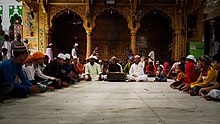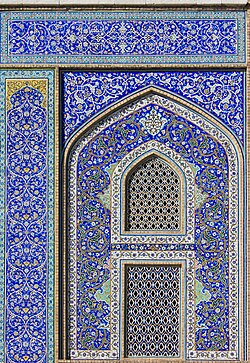다가
Dargah| 이슬람에 관한 시리즈의 일부 수피즘 |
|---|
| |
다르가(페르시아어: رگgg dargah, 터키어: dergâh, 힌두스타니: dargah, 벵골어: 벵골어: gহggg dorgah)는 존경받는 종교 인물의 무덤 위에 세워진 성지 또는 무덤이다.수피들은 종종 종교적 방문과 "순례"와 관련된 용어인 지야랏을 위해 신사를 방문합니다.Dargahs는 종종 Khanqah 또는 Hospice라고 불리는 Sufi의 식사 및 회의실 및 호스텔과 관련이 있습니다.이들은 보통 모스크, 회의실, 이슬람 종교 학교(마드라사), 교사나 간병인을 위한 주거지, 병원 및 지역사회 목적을 위한 기타 건물을 포함한다.
아랍어권에서는 같은 사회적 의미와 같은 종류의 의식 관행을 가진 같은 구조물을 마캄이라고 부른다.
오늘날 다가는 성인들이 기도하고 중재하는 장소로 여겨진다.사당은 항상 그렇지는 않지만 실제 다가를 아우르는 현대식 건물이다.
어원학
다가는 말 그대로 "포털" 또는 "임계점"[1]을 의미하는 페르시아어에서 유래했다.페르시아어는 "문, 문"을 뜻하는 "다르(dar)"와 "장소"를 뜻하는 "가(gah)"It may have a connection or connotation with the Arabic word "darajah (دَرَجَة)" meaning "stature, prestige, dignity, order, place" or may also mean "status, position, rank, echelon, class" Some Sufi and other Muslims believe that dargahs are portals by which they can invoke the deceased saint's intercession and blessing (as per tawassul, also known as dawat-e qabooor[2] [페르시아어: da'wat-i qaburت]또는 [일름-i dawat] 또는 [일름-i da'wat, "발명의 지식"입니다.그러나 다른 사람들은 다가에 대한 덜 중요한 관점을 가지고 있고, 단순히 죽은 경건한 개인들에게 경의를 표하기 위한 수단이나 인식된 영적인 이익을 위해 그 장소에서 기도하기 위한 수단으로 방문한다.
하지만, 다가는 원래 이슬람 수피교의 핵심 개념이고 수피교의 추종자들에게 매우 중요하다.많은 이슬람교도들은 그들이 따르는 성인의 다가(dargah)에서 기도나 예배를 드린 후에 그들의 소원이 이루어졌다고 믿는다.신자들은 달가에 마나트(페르시아어: نّ "ت, " ",, 호의, 칭찬")의 실을 묶고 랑가르에 기여하고 달가르에서 기도한다.다가스는 [3]인도 아대륙이 분할되기 전부터 펀자브의 풍경을 점점이 찍혔다.
시간이 흐르면서, 독실한 신자들 앞에서 더비시와 셰이크를 바치는 음악적인 제물은, 대개 즉흥적이거나 우르스가 있을 때, 카피와 같은 음악 장르를 만들어 냈습니다. 카피에서는 수피 시는 음악과 함께 수피의 정신적 지도자인 무르시드에게 바치는 제물로 노래됩니다.오늘날 그들은 누스랏 파테 알리 칸과 아비다 파르빈과 같은 가수들이 그들의 음악을 세계 [4][5]각지로 가져가면서 남아시아 전역에서 인기 있는 음악과 엔터테인먼트의 형태가 되었다.
비아랍계 이슬람권 전체
수피 사당은 전 세계의 많은 이슬람 공동체에서 발견되고 많은 이름으로 불린다.다가라는 용어는 페르시아의 영향을 받은 이슬람 세계, 특히 이란, 터키, 남아시아에서 [6]흔하다.
남아프리카공화국에서 이 용어는 인디언의 존재가 강한 더반 지역의 성지를 묘사하기 위해 사용되는 반면 케라마트라는 용어는 케이프 말레이 문화가 [7]강한 케이프 타운에서 더 일반적으로 사용됩니다.
남아시아에서, 다가는 종종 죽은 성인을 기리는 축제 장소이다.신사는 이때 [8]촛불이나 전등줄로 불을 밝힌다.남아시아의 다가는 중세 시대부터 역사적으로 모든 신앙을 위한 장소였다. 예를 들어, 아주머 샤리프 다가는 힌두교도와 이슬람교도들이 존경하고 심지어 존경받는 성 무인 알-딘 [9][10]치쉬티에게 경의를 표하기 위해 만나고 있었다.
중국에서 공베이라는 용어는 보통 수피 성인의 [11]무덤을 중심으로 한 신사 단지를 일컫는다.
전 세계적으로
전 세계에는 많은 활동적인 다가들이 공개되어 있는데, 그곳에서는 희망자들이 휴식을 취할 수 있다.다음은 일반에 공개된 다가의 목록입니다.
- 라제 바그사바르 다르가, 카트군, 인도, 사타라
- 이라크 바그다드에 있는 압둘 카디르 질라니 성지
- 파키스탄 세환 샤리프에 있는 랄 샤바즈 칼란다르 성지
- 파키스탄 두트로 샤리프에 있는 피르 하디 하산 벅스 샤 질라니 성지
- 파키스탄 카수르에 있는 바바 불레 샤 성지
- 파키스탄 세환 샤리프에 있는 무르시드 나디르 알리 샤의 성지
- 파키스탄 라호르에 있는 데이터 다바
- 방글라데시 실렛의 샤 잘랄 다르가
- 인도 라자스탄주 아즈메르, 모이누딘 치슈티의 아즈메르 샤리프 다르가
- 인도 우타르프라데시주 아슈라프푸르 키하우샤에 있는 아슈라프 자한기르 셈나니 성지
- 인도[12] 서벵골 강가람푸르 샤아타의 다르가
- 인도, 타밀나두, 에르와디
- 인도 타밀나두 주, 나고르
- 인도, 타밀나두, 티루파란쿤드람다르가
- 이집트 후마시아라
- 마두라이 하즈랏 막바라, 마두라이, 타밀나두, 인도[13]
- 키프로스[14] 레프카의 셰이크 나짐 알 하카니
다른 수니파 단체들의 반대
알-이 하디스, 데오반디, 살라피, 와하비 종교학자들은 무덤 위에 성지를 짓는 관행에 반대하며, 그것을 신과 협력하거나 [15]회피하는 것으로 간주한다.이슬람 예언자 무함마드는 무덤을 예배 장소로 바꾸는 관행을 강하게 비난하고 심지어 그렇게 [16][17]한 사람들을 저주했다.현재 사우디의 와하비 통치자들은 [20][21][22]1400년 이상 된 동료와 알-바이트의 무덤을 파괴했다. 비록 이슬람에서는 죽음과 심판의 날을 기억하기 위해 [18][19][20]성묘를 장려하고 있지만 말이다.
「 」를 참조해 주세요.
레퍼런스
- ^ Delage, Remy; Boivin, Michel (2015). Devotional Islam in Contemporary South Asia: Shrines, Journeys and Wanderers. Routledge. ISBN 978-1317380009.
- ^ Bilgrami, Fatima Zehra (2005). History of the Qadiri Order in India. Idarah-i Adabiyat-i Delli. p. 291.
- ^ Snehi, Yogesh (October 2013). "Replicating Memory, Creating Images: Pirs and Dargahs in Popular Art and Media of Contemporary East Punjab". Retrieved 2020-06-07.
- ^ 카피 남아시아 민속: 백과사전: 아프가니스탄, 방글라데시, 인도, 네팔, 파키스탄, 스리랑카, 피터 J.클로스, 사라 다이아몬드, 마가렛 앤 밀스.Taylor & Francis, 2003.ISBN 0-415-93919-4. 페이지 317.
- ^ Geeti Sen의 카피 크로싱입니다.오리엔트 블랙스완, 1998년ISBN 8125013415. 페이지 133.
- ^ Alkazi, Feisal (2014). Srinagar: An Architectural Legacy. New Delhi: Roli Books. ISBN 978-9351940517.
- ^ Acri, Andrea; Ghani, Kashshaf; Jha, Murari K.; Mukherjee, Sraman (2019). Imagining Asia(s): Networks, Actors, Sites. Singapore: ISEAS. ISBN 978-9814818858.
- ^ Currim, Mumtaz; Michell, George (1 September 2004). Dargahs, Abodes of the Saints. Mumbai: Marg Publications. ISBN 978-8185026657.
- ^ Khan, Motiur Rahman (2010). "Akbar and the Dargah of Ajmer". Proceedings of the Indian History Congress. Idarah-i Adabiyat-i Delli. 71: 226–235. ISSN 2249-1937. JSTOR 44147489.
- ^ "How Dargahs Unite People Of All Faiths". nayadaur.tv. 24 November 2020.
- ^ "Muslim Architecture". China.org. Retrieved 2020-06-07.
- ^ "History of Dargah of Shah Ata". Asikolkata.in. ASI, Kolkata Circle. Retrieved 2017-08-22.
- ^ "Maqbara.com – Madurai Hazraths Maqbara".
- ^ "Sheikh Nazım Al Haqqani Al Qubrusi An Naqshibandi". Retrieved 6 April 2016.
- ^ "Building Mosques or Placing Lights on Graves" (PDF). 21 March 2008. Retrieved 11 July 2014.
- ^ "Sahih Muslim 528a - The Book of Mosques and Places of Prayer - Sunnah.com - Sayings and Teachings of Prophet Muhammad (صلى الله عليه و سلم)".
- ^ "Sahih al-Bukhari 3453, 3454 - Prophets - Sunnah.com - Sayings and Teachings of Prophet Muhammad (صلى الله عليه و سلم)".
- ^ "Sunan an-Nasa'i 2048 - The Book of Funerals - Sunnah.com - Sayings and Teachings of Prophet Muhammad (صلى الله عليه و سلم)". sunnah.com.
- ^ "Sunan an-Nasa'i 2047 - The Book of Funerals - Sunnah.com - Sayings and Teachings of Prophet Muhammad (صلى الله عليه و سلم)". sunnah.com.
- ^ a b Ondrej, Beranek; Tupek, Pavel (July 2009). Naghmeh, Sohrabi (ed.). From Visiting Graves to Their Destruction: The Question of Ziyara through the Eyes of Salafis (PDF). Crown Paper (Crown Center for Middle East Studies/Brandeis University). Brandeis University. Crown Center for Middle East Studies. p. 19. Archived (PDF) from the original on 10 August 2018.
Relying mainly on hadiths and the Qur’an, Ibn ‘Abd al-Wahhab’s most famous work, The Book of God’s Unicity (Kitab al-tawhid), describes a variety of shirk practices, such as occultism, the cult of the righteous (salih), intercession, oaths calling on other than God himself, sacrifices or invocational prayers to other than God, and asking other than Him for help. Important things about graves are remarked on in a chapter entitled “About the Condemnation of One Who Worships Allah at the Grave of a Righteous Man, and What if He Worships [the Dead] Himself.”72 Ibn ‘Abd al-Wahhab starts by quoting a hadith: “Umm Salama told the messenger of Allah about a church she had seen in Abyssinia in which there were pictures. The Prophet said: ‘Those people, when a righteous member of their community or a pious slave dies, they build a mosque over his grave and paint images thereon; they are for God wicked people.’ They combine two kinds of fitna: the fitna of graves and the fitna of images.” He then continues with another hadith: “When the messenger of Allah was close to death, he ... said: ‘May Allah curse the Jews and Christians who make the graves of their prophets into places of worship; do not imitate them.’” From this hadith Ibn ‘Abd al-Wahhab derives the prohibition of building places of worship over graves, because that would mean glorification of their inhabitants, which would amount to an act of worship to other than Allah.
- ^ "The Book of Prayer – Funerals – Sahih Muslim". Sunnah.com – Sayings and Teachings of Prophet Muhammad (صلى الله عليه و سلم). Retrieved 6 April 2016.
- ^ "Shrine - Oxford Islamic Studies Online". www.oxfordislamicstudies.com. Retrieved 2018-08-10.
Many modern Islamic reformers criticize visits to shrines as mere superstition and a deviation from true Islam.










